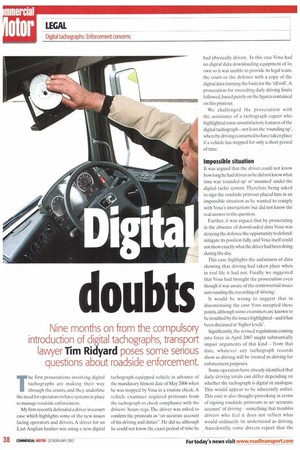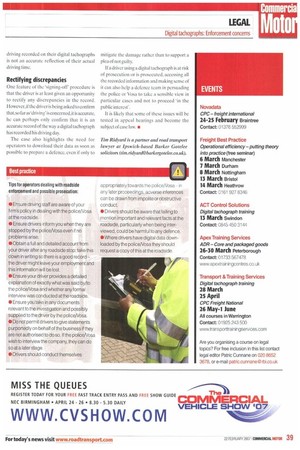doubts
Page 38

Page 39

If you've noticed an error in this article please click here to report it so we can fix it.
Nine months on from the compulsory
introduction of digital tachographs, transport
lawyer Tim Ridyard poses some serious
questions about roadside enforcement.
The first prosecutions involving digital tachographs are making their way through the courts, and they underline the need for operators to have systems in place to manage roadside enforcement.
My firm recently defended a driver in a court case which highlights some of the new issues facing operators and drivers. A driver for an East Anglian haulier was using a new digital tachograph-equipped vehicle in advance of the mandatory fitment date of May 2006 when he was stopped by Vosa in a routine check. A vehicle examiner required printouts from the tachograph to check compliance with the drivers' hours regs. The driver was asked to confirm the printouts as "an accurate account of his driving and duties". He did so, although he could not know the exact period of time he had physically driven. In this case Vosa had no digital data downloading equipment of its own so it was unable to provide its legal team, the court or the defence with a copy of the digital data forming the basis for the 'till roll'.A prosecution for exceeding daily driving limits followed, based purely on the figures contained on this printout.
We challenged the prosecution with the assistance of a tachograph expert who highlighted some unsatisfactory features of the digital tachograph -not least the 'rounding up', whereby driving is assumed to have taken place if a vehicle has stopped for only a short period of time.
Impossible situation It was argued that the driver could not know how long he had driven as he did not know what time was 'rounded up' or 'assumed' under the digital tacho system. Therefore being asked to sign the roadside printout placed him in an impossible situation as he wanted to comply with Vosa's instructions but did not know the real answer to the question.
Further, it was argued that by prosecuting in the absence of downloaded data Vosa was denying the defence the opportunity to defend/ mitigate its position fully, and Vosa itself could not show exactly what the driver had been doing during the day.
This case highlights the unfairness of data showing that driving had taken place when in real life it had not. Finally, we suggested that Vosa had brought the prosecution even though it was aware of the controversial issues surrounding the recording of 'driving'.
It would be wrong to suggest that in discontinuing the case Vosa accepted these points, although some examiners are known to be troubled by the issues highlighted-and it has been discussed at 'higher levels'.
Significantly, the revised regulations coming into force in April 2007 might substantially impair arguments of this kind from that date, whatever any tachograph records show as driving will be treated as driving for enforcement purposes.
Some operators have already identified that daily driving totals can differ depending on whether the tachograph is digital or analogue. This would appear to be inherently unfair. This case is also thought-provoking in terms of signing roadside printouts as an 'accurate account' of driving something that troubles drivers who feel it does not reflect what would ordinarily be understood as driving. Anecdotally, some drivers report that the driving recorded on their digital tachographs is not an accurate reflection of their actual driving time.
Rectifying discrepancies
One feature of the 'signing-off procedure is that the driver is at least given an opportunity to rectify any discrepancies in the record. However, if the driver is being asked to confirm that,so far as`dri vin g' is concerned,it is accurate, he can perhaps only confirm that it is an accurate record of the way a digital tachograph has recorded his driving day.
The case also highlights the need for operators to download their data as soon as possible to prepare a defence, even if only to mitigate the damage rather than to support a plea of not guilty If a driver using a digital tachograph is at risk of prosecution or is prosecuted, accessing all the recorded information and making sense of it can also help a defence team in persuading the police or Vosa to take a sensible view in particular cases and not to proceed in the public interest'.
It is likely that some of these issues will he tested in appeal hearings and become the subject of case law. • Tim Rh/yard is a partner and road transport lawyer at Ipswich-based Barker Gotelee solicitors (tim.ridyard@barketgotelee.ca.uk).
























































































































































































